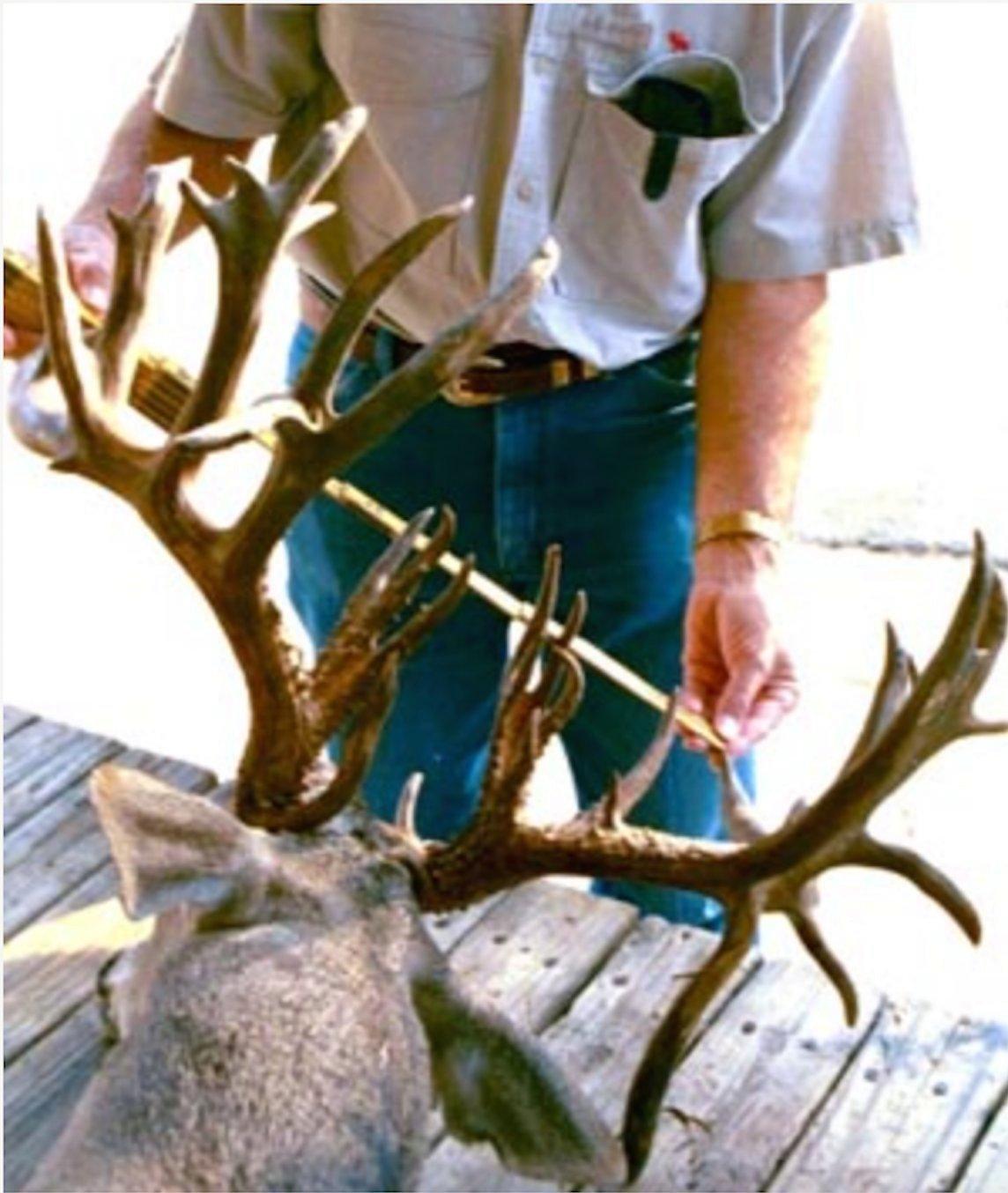36-Point Bullis Buck!

Because of where it was killed, I dubbed it the "Bullis Buck," a name that has been picked up to become the animal's identifying moniker.
About the Antlers
In the final count, as taken by Boone & Crockett scorer John Stein, the Bullis Buck rack has 36 scoreable points, including two drop tines, on a 6x6 main frame. The rack's green score nets 265 1/8 inches as measured by Stein, who offers several significant notes. Most remarkable for such a huge non-typical is the rack's symmetry: There is only 5/8-of-an-inch difference in the two sides, a fact Stein said is virtually unheard of in such circumstances.
About the Kill
Saturday, November 6, was opening day of the state deer season and at Camp Bullis, and it was a weekend for drills by military personnel. The base offers about 1,200 hunts a year to Department of Defense personnel. The hunts and the military drills have been parts of the base's routine for decades.
Around noon, a helicopter crew member spotted what appeared to be a sick deer in a remote area of the base. The deer had very large antlers. GPS coordinates were taken and forwarded to range control -- the authority for movements within the training area. Range control notified the hunt headquarters, where two civilian employees and a volunteer responded to the coordinates.
The civilians' GPS system was used to find the deer. The men found the deer lying on the ground in a muddy, trampled area. There was something obviously wrong with the deer. It faltered and appeared disoriented. Two of the men approached the animal, and it stumbled into a stand of tall grass. The two men found the animal and approached it, clapping their hands. At about 15 feet of distance, the buck got to its feet and came toward the noise, passing within touching distance of the men then staggered and finally stumbled into the grill of their pickup truck. The buck appeared to be blind.
It walked beside the truck and collapsed. The men subdued the deer and stabbed it to death (in the heart) with a small, red pocketknife with a 4-inch blade. The men used a pocketknife because federal regulations ban all civilian firearms in an area where maneuvers and military personnel are conducting operations.
The deer was loaded on the truck and taken to base hunt headquarters, where the deer was field dressed and put in cold storage. The base hunting lodge was open that weekend, and, as word spread, the animal was brought out of the chill box and put on public display for anyone who wanted to videotape or take photos of it. It was not held in secret.
The hunt club staff later used a Boone & Crockett scoring sheet they downloaded from the internet and scored the antlers at about 262 inches. At that time, one of the men said later, they realized that the deer was so large that it was important beyond their base and local hunting community.
Official Score
On Nov. 9, John Stein of San Antonio was the first official scorer to measure the antlers. He got a gross score of 271 3/8 inches (net 265 1/8 inches).
As it stands, the Bullis Buck is the third-largest native whitetail ever recorded in Texas and the largest wild white-tailed deer from the state in more than 100 years.
The Problem
On November 10, local taxidermist Dan Verrips caped the buck and took the hide to his shop. He left the antlers and carcass at Camp Bullis.
Verrips noted that as he removed the cape, he saw a large cyst or infection in the back of the Bullis Buck's skull. When he removed the skull cap from the deer, he said the infection was inside the skull. Verrips also said that he had been told the deer might have a broken back, because it had so much trouble walking. He looked carefully and said it did not appear the deer had a back injury, but he surmised the deer might have been blind and feeble.
The Law Arrives
Also on November 10, a formal investigation regarding the legal taking of the deer was opened by Texas Parks & Wildlife Department law-enforcement officials and the U.S. Fish & Wildlife Service. On November 12, the antlers were moved from the Camp Bullis locker to an evidence room at Fort Sam Houston in San Antonio. Fort Sam is the primary Army base in San Antonio. Also, Army officials sent tissue samples from the buck to Texas A&M University for analysis. The hide was taken from Verrips and placed in federal custody. The deer's carcass, which was seriously deteriorated, was discarded. State and federal wildlife law officials later went into the field and took their own samples.
State game officials later declined to issue any citations against the three civilians involved in the taking of the Bullis Buck. At possible issue had been the licensing of the individuals, the tagging of the deer, the use of aircraft in the taking of a game animal and, ultimately, the taking of a game animal by illegal means, i.e., the use of a pocket knife.
The U.S. Fish & Wildlife Service indicated that federal authorities plan no action against the three men involved in the taking of the Bullis Buck.
The antlers and other remains are being held by the feds, and their disposition and other matters regarding the case will be cleared up early in 2005.






